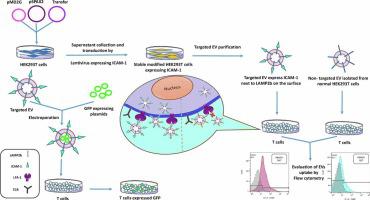Biochimica et Biophysica Acta (BBA) - General Subjects ( IF 3 ) Pub Date : 2023-12-15 , DOI: 10.1016/j.bbagen.2023.130541 Mahboube Shahrabi Farahani , Elham Hosseini-Beheshti , Seyed Mohammad Moazzeni , Mehdi Forouzandeh Moghadam

|
Background
Extracellular vesicles (EVs) are natural nano-carriers that possess the required crucial features of an ideal biomolecular delivery system. However, using unmodified EVs may have some limitations such as low accumulation in target sites. Studies have established that engineering EVs against different cell surface markers can overcome most of these hurdles.
Methods
In this study, engineered EVs expressing ICAM-1/LAMP2b fusion protein on their surfaces were produced and isolated. The uptake of isolated targeted and non-targeted EVs was evaluated by imaging and flow cytometry. To assess the ability of targeted EVs to be applied as a safe carrier, pAAVS1-Puro-GFP plasmids were encapsulated into EVs by electroporation.
Results
The HEKT 293 cell line was successfully modified permanently by a lentiviral vector to express ICAM-1 on the surface of the derived EVs. The ELISA and western blot tests established the binding affinity of targeted EVs for recombinant LFA-1 with a remarkable difference from non-targeted EVs. Furthermore, flow cytometry results revealed noteworthy differences in the binding of LFA-1-positive, non-targeted EVs, and targeted EVs to LFA-1-negative cells. Finally, imaging and flow cytometry indicated that newly produced EVs could efficiently interact with T cells and functionally deliver loaded plasmids to them.
Conclusion
These LFA-1-targeted EVs were able to interact with T cells as their recipient cells. They can be utilized as an ideal delivery system to transfer various biomolecules to T cells, facilitating immunotherapies or other cell-based treatments.
中文翻译:

表达 ICAM-1 的工程细胞外囊泡:一种有前景的 T 细胞修饰靶向递送系统
背景
细胞外囊泡(EV)是天然纳米载体,具有理想生物分子递送系统所需的关键特征。然而,使用未经修改的电动汽车可能有一些限制,例如目标位点的积累较低。研究表明,针对不同细胞表面标记物设计电动汽车可以克服大部分障碍。
方法
在这项研究中,生产并分离了在其表面表达 ICAM-1/LAMP2b 融合蛋白的工程化 EV。通过成像和流式细胞术评估分离的靶向和非靶向 EV 的摄取。为了评估靶向 EV 作为安全载体的能力,通过电穿孔将 pAAVS1-Puro-GFP 质粒封装到 EV 中。
结果
HEKT 293 细胞系成功地被慢病毒载体永久修饰,以在衍生的 EV 表面表达 ICAM-1。ELISA和蛋白质印迹测试确定了靶向EV与重组LFA-1的结合亲和力与非靶向EV有显着差异。此外,流式细胞术结果显示,LFA-1 阳性、非靶向 EV 和靶向 EV 与 LFA-1 阴性细胞的结合存在显着差异。最后,成像和流式细胞术表明新产生的 EV 可以有效地与T 细胞相互作用,并功能性地将负载的质粒传递给它们。
结论
这些靶向 LFA-1 的 EV 能够与作为受体细胞的 T 细胞相互作用。它们可用作理想的递送系统,将各种生物分子转移至 T 细胞,促进免疫疗法或其他基于细胞的治疗。



























 京公网安备 11010802027423号
京公网安备 11010802027423号